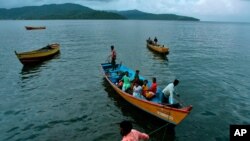The coronavirus has hit a threatened tribe in India’s Andaman and Nicobar Islands, raising concerns about the impact the pandemic could have on other endangered tribes in the archipelago that lies off the mainland.
Authorities say 10 cases have been detected among the Great Andamanese tribe, whose numbers have dwindled to 56.
The string of islands is home to several endangered tribes that live in isolation in secluded areas, and access is barred for outsiders.
Some members of the Great Andamanese, however, have integrated more closely with the mainstream population and travel to and even work in the archipelago’s main city, Port Blair. It was among this group that six coronavirus infections were initially diagnosed — authorities say these persons have recovered.
But red flags were raised after four people living in the remote Strait Island, where the tribe is based, also tested positive this week. Two have been admitted to the hospital, while two are at an isolation center.
A health official posted at Strait Island is keeping a close watch to monitor other tribe members for the infection, according to Avijit Roy, joint secretary, Health, Andaman and Nicobar Islands.
Authorities also are stepping up measures to watch four other endangered tribes that anthropologists fear could be at risk as the pandemic rages in India.
The number of these tribes is about 900. Having lived in seclusion for centuries, they are extremely susceptible to diseases brought in from the outside, authorities say.
The 500 or so members of the nomadic Jarawas, in particular, are believed to be particularly vulnerable. Authorities say they moved the tribe along the farthest edge of the jungle after the pandemic began ravaging India to ensure they are isolated. Authorities also have restricted movement on a huge road that cuts through their forest reserve and exposes them to outsiders.
Isolation offers no protection
But some anthropologists say they fear this is not enough. “The Jarawas are in the interior forests so some say nothing is going to happen, but the road here has turned this into a porous area,” points out anthropologist Vishvajit Pandya, director of the Andaman and Nicobar Tribal Research and Training Institute.
Poachers and fishermen, for example, can pose a problem. “Nobody can give an assurance that the area is completely sealed off from outsiders,” according to Pandya.
London-based Survival International, which works for tribal people’s rights, has called on authorities to ensure the tribes are protected from the pandemic.
“The Andaman authorities must act urgently to prevent the virus from reaching more Great Andamanese and to prevent infection in the other tribes," Survival senior researcher Sophie Grig said. “The waters around North Sentinel must be properly policed, and no outsiders should enter the territories of any of the Andaman tribes without their consent.”
Pandya says more of an effort should be made to communicate coronavirus symptoms to the tribal members so that they are alerted to the pandemic. “They are like any other person who is susceptible to COVID. There is concern whether medical facilities are reaching there or not,” he says. COVID-19 is the disease caused by the coronavirus.
The number of these tribes has been reduced drastically. For example, the Great Andamanese, who now number at 56, were estimated to be about 5,000 strong when the British colonized the islands in the mid-19th century.
The indigenous tribes have in the past been decimated by outbreaks of measles, influenza and syphilis.
“They are completely conditioned to their own environment. An external element, an external infection disturbs the equilibrium they have developed,” says Soumendra Patnaik, an anthropology professor at Delhi University.
The Andaman and Nicobar islands initially reported only a handful of infections of COVID-19, but cases have surged since mid-July, and they have reported nearly 3,000 infections to date.
India is now the world’s third most affected country with nearly 3.4 million infections and more than 61,000 deaths, according to Johns Hopkins University, which is tracking cases globally.
In India, Coronavirus Infections Among Endangered Tribe Raise Concerns




